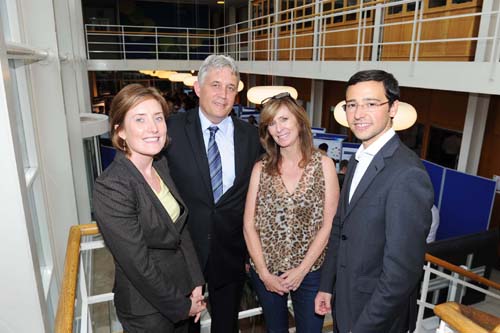Computer Science Postgraduates Present Leading-edge Research to Industry
Posted on: 10 September 2012
A postgraduate research showcase highlighting cutting-edge developments in Computer Science was recently attended by more than 100 industry guests. In his opening address, Head of the School of Computer Science and Statistics, Professor Jeremy Jones, detailed upward trends in the enrolment of students within Computer Science and associated disciplines at Trinity. These trends were very much welcomed by the industry guests present who seek to find highly skilled graduates to fill positions in their companies.
The showcase of MSc dissertations reflected the leading research in technology that is taking place in the School. Projects included the development of techniques to map facial movements on different virtual characters; a location-aware smartphone safety application that alerts pedestrians and drivers of an impending collision; innovative wireless architectures for patient health monitoring systems; cloud based model checkers to provide a cloud based solution for algorithm adaptation; home energy use optimisation; use of teamwork and technology to teach without teachers; and the demonstration of mobile and web projects at the intersection of technology, art and design.

Professor Jeremy Jones, Head, School of Computer Science and Statistics, second from left at the Showcase 2012 with Ruth Kearney, TCD/UCD Innovation Academy, Vicki Lynne Wisuri, postgraduate student and Francesco Calabrese, IBM Research Dublin
Keynote speaker, Francesco Calabrese, Leader of the Smarter Urban Dynamics Group at the newly formed IBM Research Lab in Dublin discussed the wide spectrum of activities the students engaged in and how the skills they had acquired over their postgraduate study were very much a match with those in industry and in IBM.
Mobile and Ubiquitous Computing student Vicki Lynne Wisuri developed a mobile Electromyography (EMG) system. EMG is used by physiotherapists, chiropractors and other healthcare professionals to measure muscle activity diagnose problems and track patient recovery. Most EMG systems are bulky and expensive. Vicki’s mobile EMG system is a small, battery operated unit that can be attached to the body like an iPod armband.
Using the mobile EMG system, patients can record their muscle activity on a mobile phone or laptop. This information can then be sent to a professional for diagnosis. One application of Vicki’s system would allow a physiotherapist to determine whether a patient is performing an exercise correctly, or performing it at all, without the need for the patient to attend a hospital.
Guest speaker Ruth Kearney from the TCD/UCD Innovation Academy said: “To be expert in your discipline is important but the real magic happens when you get outside your comfort zone and cross disciplines. The work on display by the students crosses those boundaries. It is great to see such a variety of projects from medical to e-learning and advances in digital technologies from human gestures and divergent thinking. All this and with real world applications, which I have no doubt that many students will take to the next level, is very exciting”.
Further details on all projects are available at Showcase 2012
